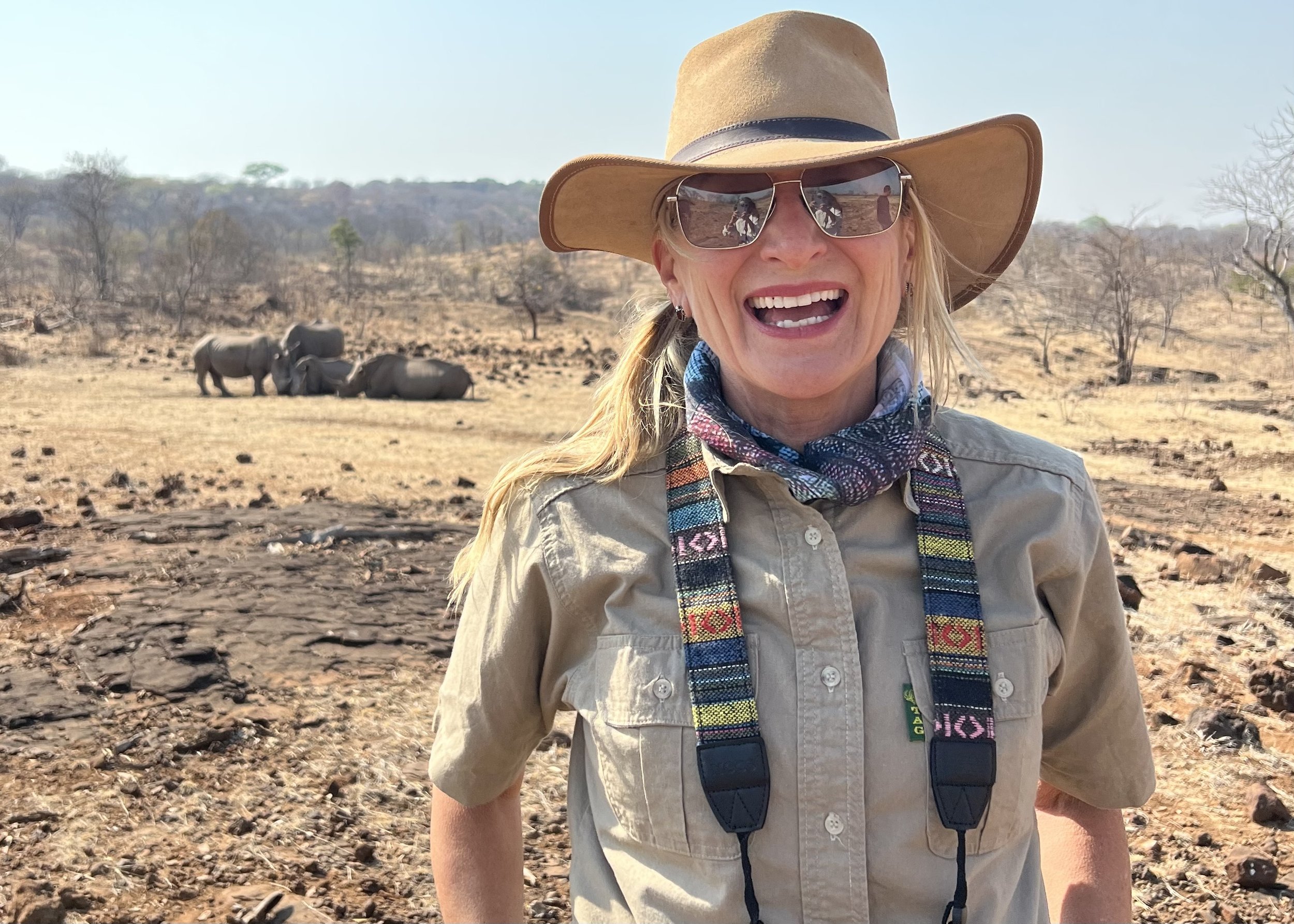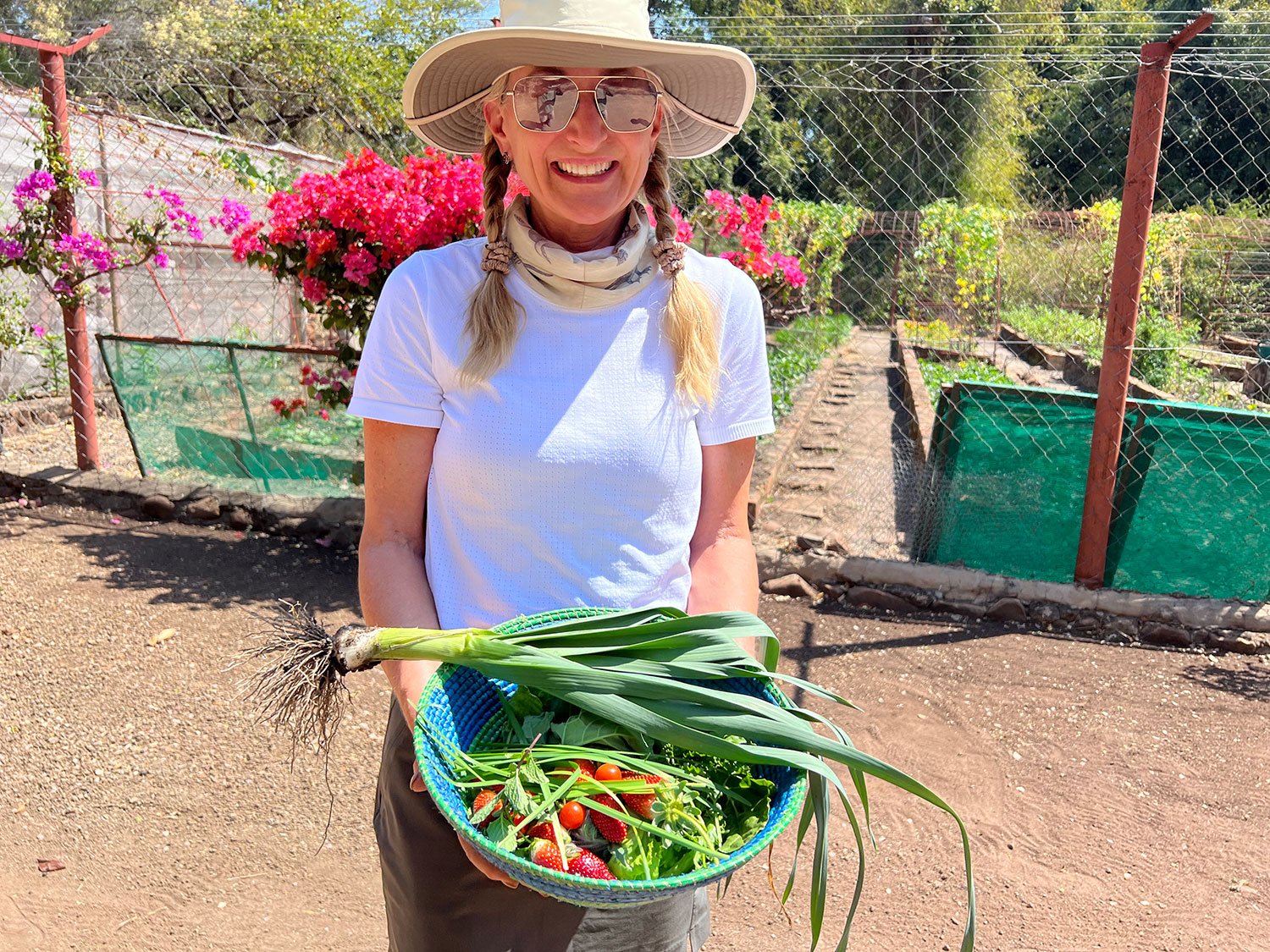Lower Zambezi and Victoria Falls, Zambia: Wild Times On Safari
We arrive in Lower Zambezi with friends from Santa Fe: Will, Marcellin, Charles, and Leigh. It takes a small prop plane and a boat to get to Sausage Tree Camp. I love to sit next to the pilot and see the land from the sky, but not all of my traveling companions feel the same way. Some of us need a flask of wine and a Valium or two. Woozy and finally on the ground, we grab our small duffle bags and backpacks. Everything has to squash down when you fly like this, no hard-sided luggage allowed. That’s it for a month-long trip. (Thank goodness they do laundry for you at the camps.)
On a pontoon boat, we pass rafts of hippos standing in the river. They are all eyes and ears. Our guide tells us that hippos don’t have sweat glands, so they must soak to stay cool. However, they can live on land if there’s plenty of shade. Here in the Lower Zambezi, they are everywhere and mostly in the water. Humans can only hear 20% of the sounds they make, which fluctuate between a very loud hum and an ear-shattering snort.
We have to be escorted to our room by a scout. Apparently, there are elephants and buffalo in the area and often on the path between the main lodge and the huts. One snap of a branch in front of a mother and her baby, and we could be toast. When I look around, I don’t see any wildlife. “I can’t believe we have to have an escort every time we want to go back to our room,” I say. “Robin, we’re in Africa, not on Cerrillos Road in Santa Fe,” Will reminds me.
The rooms are elegant white canvas tents with a spot-on view of the river. There’s a separate sitting area, a bedroom with sliding doors out to a private plunge pool, and an enormous bathroom. I could live here comfortably forever—that is, until the rainy season when the river rises, and the entire camp could get swept away.
After tea, we go out for a drive and see a leopard perched in a tree. She is glamorous and green-eyed. Our guide tells us that the leopard has held this territory for some time and that she feels queenly with us watching her. I look through my binoculars and see a dead impala in the tree next to her. The leopard’s spotted coat is immaculate. She’s a cunning and clean killer.
On our walking safari, our guide tells us dozens of fun facts. Giraffes on the move are called a “journey of giraffes.” If they’re standing still together, the group is called a “tower of giraffes.” A full-grown giraffe’s heart is two feet long and weighs 20 pounds. Elephants eat 200 to 400 kilograms (about 882 pounds!) of grass daily but only digest 40% of that food. We examine their dung and see undigested palm nuts that the baboons love to eat.
A BBC documentary on wild dogs is being filmed. We meet the crew who are using drones to find the packs. We follow their directions and come upon a den of dogs. Painted black, tan, and cream, they play like our puppies back home but are vicious hunters and can take down a large impala. Although they are an endangered species, the wild dogs here are protected by park rangers and they thrive. We count 21 adults and 12 puppies.
In this part of Zambia, we take the “hippo highways” to the spot game. Turns out the hippos like to take the same routes and over time a well-worn path is formed as hippos move from water to feeding grounds on land. One morning, we are walking in the bush and come across an enormous bull shaking an Acacia Tree (also known as a Winter Thorn) for “elephant biscuits.” We keep our distance as orange seed-filled pods flutter to the ground. The bull vacuums them up with his trunk. Our guide tells us that in the village, mothers give elephant biscuits to their babies for rattles.
Sausage Tree knows how to delight its guests. One morning, the camp staff surprises us with brunch in the bush. The chef is frying eggs over an open fire along with bacon, sausage, and chicken. The staff delivers service beyond any I’ve ever experienced in the world. Two examples: We are treated to a lavish buffet served under a canape in the shallow water of the river. During one of our nights there, our enormous bathtub was filled with floating candles and the word “ENJOY” was spelled out in flowers in front of it. Just stunning.
A few days later, we fly to Livingstone and check into Tongabezi. The lobby has framed articles about my friend William Ruck, who sadly passed away from an untimely death. His legacy lives on in the paradise he envisioned. Brian and I feel like Tarzan and Jane in the Treehouse Room. It’s totally tucked away and completely open to the river. There’s an old fashioned clawfoot bathtub and outdoor shower, romantic bed draped with mosquito netting and beautiful furnishings. Agatha and Lizzy take care of our every whim. They are kindhearted mothers and the abandoned child in me feels nurtured and safe.
We complete our “Big Five” list of animals and finally see a “crash” of rhinos. Protected 24 hours a day from poachers by armed scouts, they are utterly beautiful to me. Together with Brian, we stand in awe of their tough grey skin, tiny eyes, and massive horns. “How can anyone kill these incredible animals?” I ask Brian. He hugs me, feeling my soft heart and deep appreciation for all that we’ve experienced on this incredible trip.
In the evening, a local choir performs traditional songs in four-part harmony. They are marvelously entertaining. The following day, children of various ages from the nearby Tongabezi School sing for us about living in the village and how much they love their mothers. With a full heart, I walk to the camp’s garden and pick lettuce and veggies for my lunch. Mishick, who manages it, tells me that he attended the school and went on to study agriculture at college.
We helicopter over Victoria Falls and then see it on foot, letting the cool spray wash over us. It’s one of those moments when you want to pinch yourself and say, “Can-you-believe-we-are-here? It’s massive and majestic, spilling over the borders of two countries: Zambia and Zimbabwe. We opt out of braving Devil’s Pool at the edge of the falls or bungee jumping off Victoria Falls Bridge. We all agree that it’s harrowing enough to swoop up by helicopter up over the falls and dip down into the beautiful Batoka Gorge.
The six of us are taken by boat to a picnic lunch on a small island near our camp. On a long table under shady trees, we devour greens from the garden, braised beef, pasta salad, and fruit, which taste even better with crisp South African Chenin Blanc. With our toes in the sand and our bellies full, we ask Agatha and Lizzy to take pictures of our happy group as we live by the safari motto: Take nothing but photos, leave nothing but footprints.















